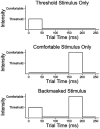Utilization of peripheral nerve feedback at a preconscious level
- PMID: 38550562
- PMCID: PMC10977079
- DOI: 10.3389/fnins.2024.1336431
Utilization of peripheral nerve feedback at a preconscious level
Abstract
Introduction: Sensorimotor integration is important, if not required, when using our hands. The integration of the tactile and motor systems is disrupted in individuals with upper limb amputations because their connection to their fingertips is lost. Direct cortical stimulation allows for modality and location matched perceptions; however, studies show that the time to process and act upon direct cortical feedback significantly exceeds the time to do the same with naturally produced tactile feedback. Direct cortical stimulation does not engage multiple parallel structures in the brain stem meant to integrate tactile feedback with signals from the motor system at a sub-perceptual or pre-perceptual level before the somatosensory cortex is involved. While reasonable to assume, it is not known if the artificially generated signals will engage the same peripheral tactile pathways to the pre-perceptual and perceptual structures as natural tactile sensation. Our hypothesis is that pre-perceptual structures will process the electrically generated neural activity as it would naturally generated neural activity.
Methods: In this study, stimulation of the median nerve in multiple subjects' residual limbs produced modal, and location matched sensory perceptions in their hands. We found the time to process different stimuli using simple reaction time tests in three different formats.
Results: We showed the minimum time to process peripheral nerve stimulation and initiate a motor plan is similar to naturally generated tactile feedback and is processed upwards of 50 - 175 ms faster than visual feedback alone. We also found the effect of stimulation intensity on the rate of feedback processing follows the same trend of natural sensory feedback, Piéron's law indicating that the unimodal processing of PNS is similar to natural touch. Finally, we found that tactile feedback given to a pre-perceptual level is again used in the motor plan.
Discussion: Taken together, we conclude that peripheral nerve stimulation engages the pre-perceptual pathways of the brain, and hence demonstrate advantages of peripheral restoration of sensory inputs.
Keywords: Piéron’s law; attentional blink; dorsal column; neuroaxis; peripheral nerve stimulation; preconscious; sensorimotor interaction; simple reaction time.
Copyright © 2024 Chowdhury and Tyler.
Conflict of interest statement
DT has a patent on the CFINE: US20140364879A1. The remaining author declares that the research was conducted in the absence of any commercial or financial relationships that could be construed as a potential conflict of interest.
Figures











References
-
- Antfolk C., Dalonzo M., Controzzi M., Lundborg G., Rosen B., Sebelius F., et al. . (2013). Artificial redirection of sensation from prosthetic fingers to the phantom hand map on Transradial amputees: vibrotactile versus mechanotactile sensory feedback. IEEE Trans. Neural Syst. Rehabil. Eng. 21, 112–120. doi: 10.1109/tnsre.2012.2217989, PMID: - DOI - PubMed
-
- Baker S. J., Maurissen J. P. J., Chrzan G. J. (1986). Simple reaction time and movement time in normal human volunteers: a long-term reliability study. Percept. Mot. Skills 63, 767–774. doi: 10.2466/pms.1986.63.2.767 - DOI
LinkOut - more resources
Full Text Sources

